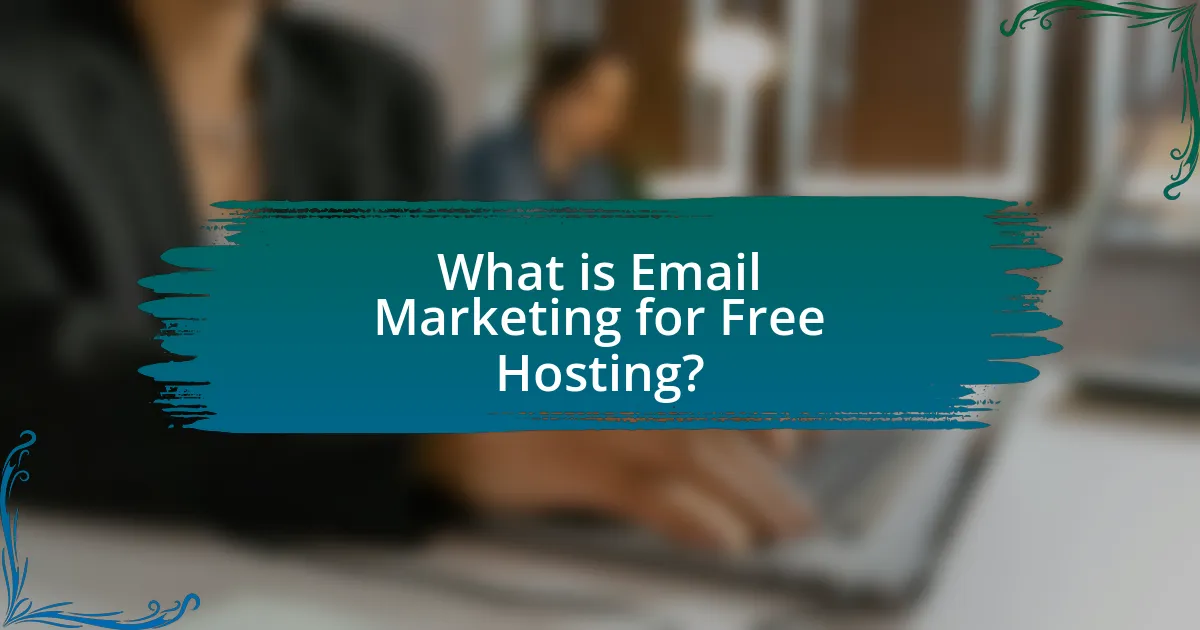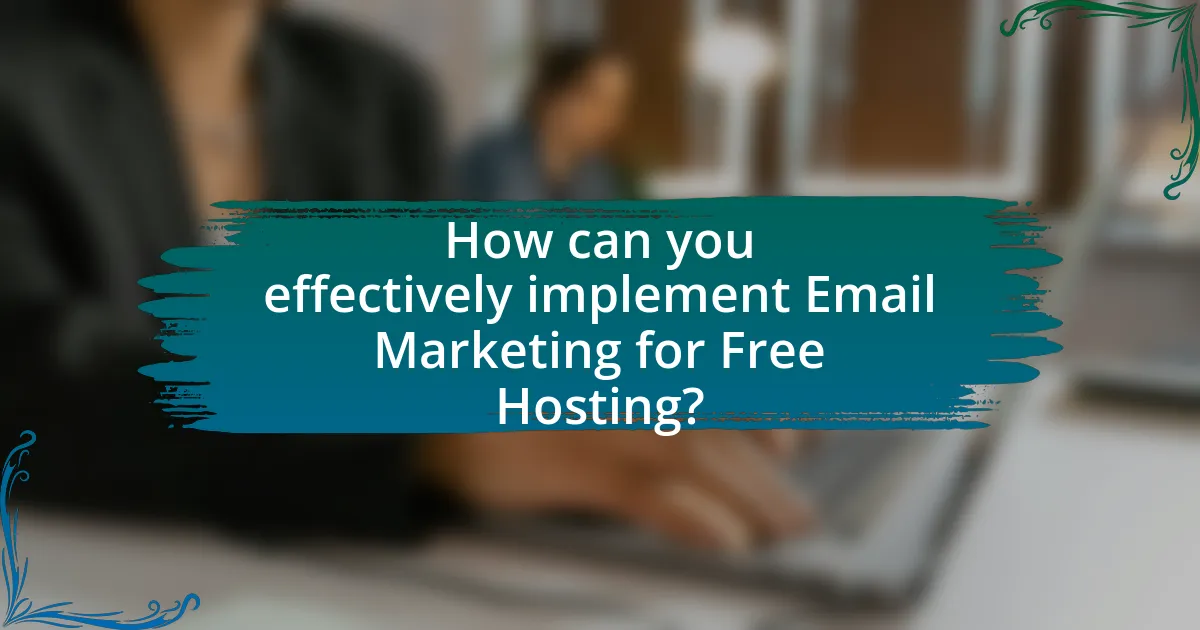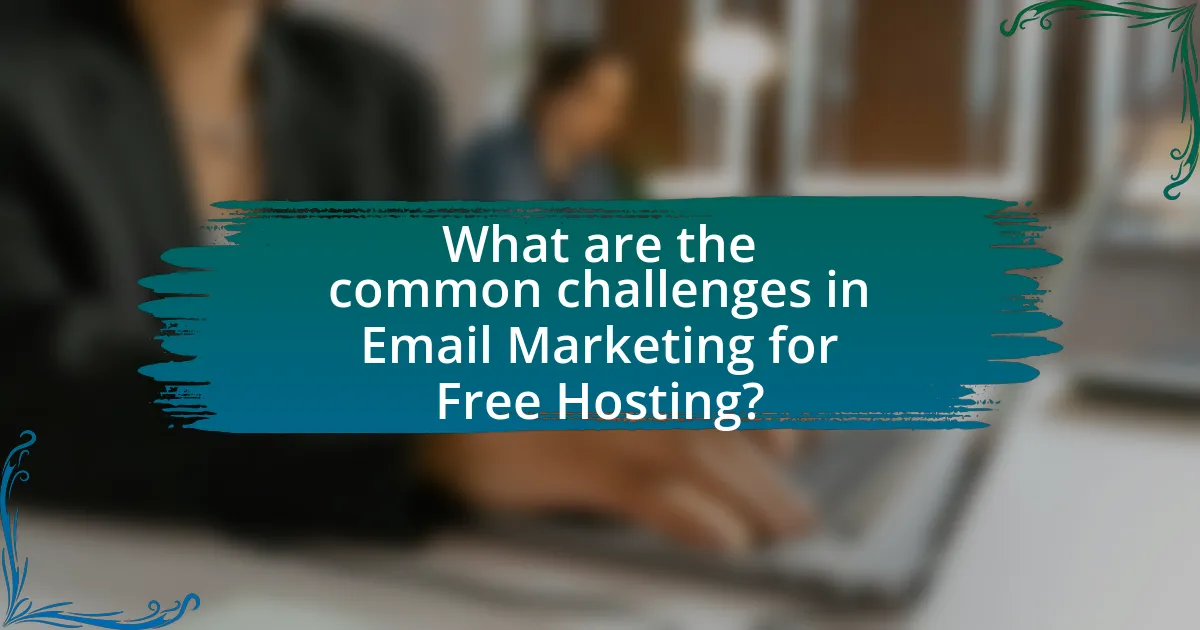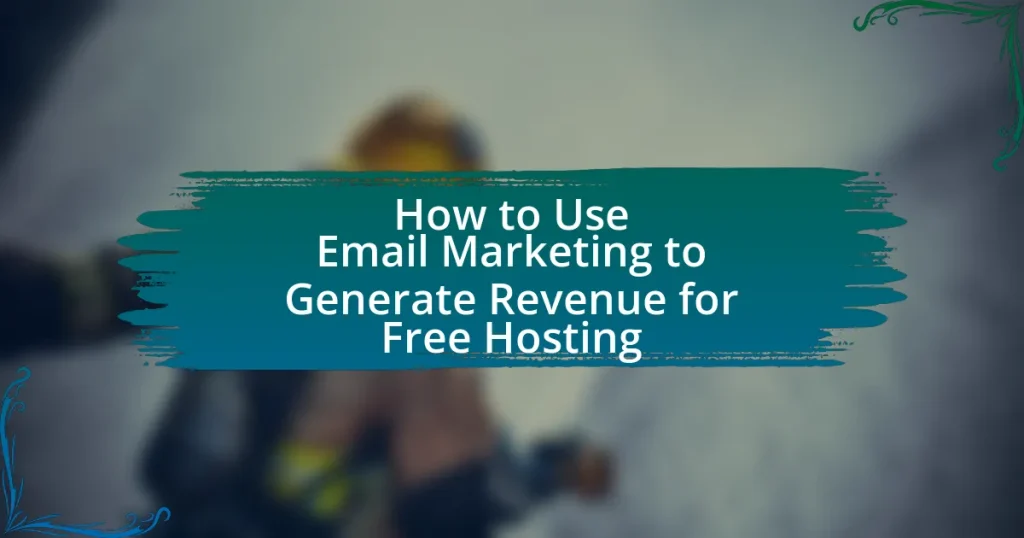Email marketing for free hosting is a strategic approach that utilizes email campaigns to promote free hosting services, aiming to attract users and generate revenue through upselling or advertising. This article outlines how email marketing operates within the context of free hosting, emphasizing key components such as targeted email lists, engaging content, and performance analytics. It discusses the advantages of email marketing, including cost-effectiveness and enhanced customer engagement, while also addressing common challenges and best practices for implementation. Additionally, the article highlights effective strategies for audience segmentation, content creation, and measuring campaign success to optimize revenue generation for free hosting services.

What is Email Marketing for Free Hosting?
Email marketing for free hosting refers to the practice of using email campaigns to promote free hosting services, aiming to attract users and generate revenue through upselling or advertising. This strategy leverages the low-cost nature of free hosting to build a subscriber base, allowing businesses to send targeted promotional content, updates, and offers to potential customers. According to a study by the Direct Marketing Association, email marketing has an average return on investment of $42 for every dollar spent, highlighting its effectiveness in driving conversions and revenue, even for free hosting services.
How does Email Marketing work in the context of Free Hosting?
Email marketing in the context of free hosting operates by utilizing email campaigns to promote services, engage users, and drive conversions without incurring hosting costs. Free hosting providers often leverage email marketing to communicate with their user base, offering promotions, updates, and educational content that encourages users to upgrade to paid plans or purchase additional services.
For instance, a free hosting service may send targeted emails to users highlighting the benefits of premium features, such as increased storage or enhanced security, thereby incentivizing upgrades. According to a study by the Direct Marketing Association, email marketing has an average return on investment of $42 for every dollar spent, demonstrating its effectiveness in generating revenue even for free hosting platforms.
What are the key components of Email Marketing for Free Hosting?
The key components of Email Marketing for Free Hosting include a targeted email list, engaging content, effective subject lines, and performance analytics. A targeted email list ensures that messages reach individuals interested in free hosting services, increasing the likelihood of engagement. Engaging content, such as informative articles or promotional offers, captures the audience’s attention and encourages action. Effective subject lines are crucial for improving open rates, as they create curiosity and urgency. Lastly, performance analytics allow marketers to track metrics such as open rates, click-through rates, and conversions, enabling continuous improvement of email campaigns. These components collectively enhance the effectiveness of email marketing strategies for free hosting services.
How do these components contribute to revenue generation?
Email marketing components contribute to revenue generation by effectively engaging potential customers and driving conversions. Targeted email campaigns can increase customer retention rates by up to 80%, as personalized content resonates more with recipients, leading to higher open and click-through rates. Additionally, integrating promotional offers within emails can directly influence purchasing decisions, with studies showing that email marketing has an average return on investment of $42 for every dollar spent. This demonstrates that well-crafted email marketing strategies not only enhance customer relationships but also significantly boost sales and revenue for free hosting services.
What are the advantages of using Email Marketing for Free Hosting?
Email marketing for free hosting offers several advantages, including cost-effectiveness, direct communication, and audience engagement. Cost-effectiveness is significant because businesses can reach a large audience without incurring high expenses, as many email marketing platforms offer free or low-cost options. Direct communication allows businesses to send personalized messages to their subscribers, enhancing customer relationships and increasing the likelihood of conversions. Additionally, email marketing fosters audience engagement by enabling businesses to share updates, promotions, and valuable content, which can lead to higher retention rates and customer loyalty. According to a study by the Direct Marketing Association, email marketing has an average return on investment of $42 for every dollar spent, underscoring its effectiveness in generating revenue even for free hosting services.
How does Email Marketing enhance customer engagement?
Email marketing enhances customer engagement by delivering personalized content directly to the inbox of subscribers, fostering a sense of connection and relevance. This direct communication allows businesses to tailor messages based on customer preferences and behaviors, which can lead to higher open and click-through rates. According to a study by Campaign Monitor, personalized emails can generate up to six times higher transaction rates compared to non-personalized emails. Additionally, email marketing enables businesses to segment their audience, ensuring that the right message reaches the right people at the right time, further increasing engagement levels.
What role does Email Marketing play in building brand loyalty?
Email marketing plays a crucial role in building brand loyalty by fostering direct communication and personalized engagement with customers. This strategy allows brands to deliver tailored content, promotions, and updates that resonate with individual preferences, thereby enhancing customer satisfaction and retention. According to a study by the Direct Marketing Association, email marketing has an average return on investment of $42 for every dollar spent, indicating its effectiveness in maintaining customer relationships. Furthermore, consistent and relevant email communication reinforces brand identity and keeps the brand top-of-mind, which is essential for cultivating long-term loyalty.

How can you effectively implement Email Marketing for Free Hosting?
To effectively implement email marketing for free hosting, create targeted email campaigns that highlight the benefits of your hosting services. Utilize a segmented email list to tailor messages based on user interests and behaviors, ensuring higher engagement rates. According to a study by Mailchimp, segmented campaigns can lead to a 14.31% higher open rate compared to non-segmented campaigns. Additionally, incorporate clear calls-to-action that encourage recipients to sign up for your hosting services or explore additional features. By consistently analyzing campaign performance metrics, such as open rates and click-through rates, you can refine your strategies to maximize effectiveness and drive revenue.
What strategies should be employed for successful Email Marketing?
Successful email marketing strategies include segmenting your audience, personalizing content, optimizing subject lines, and analyzing performance metrics. Segmenting your audience allows for targeted messaging, which can increase engagement rates; for instance, studies show that segmented campaigns can lead to a 760% increase in revenue. Personalizing content, such as using the recipient’s name or tailoring offers based on past behavior, enhances relevance and boosts open rates. Optimizing subject lines is crucial, as 33% of email recipients decide whether to open an email based solely on the subject line. Finally, analyzing performance metrics, such as open rates and click-through rates, enables marketers to refine their strategies and improve future campaigns.
How can you segment your audience for targeted campaigns?
To segment your audience for targeted campaigns, utilize demographic, psychographic, behavioral, and geographic data. Demographic segmentation involves categorizing your audience based on age, gender, income, and education, which allows for tailored messaging that resonates with specific groups. Psychographic segmentation focuses on lifestyle, values, and interests, enabling campaigns to align with the audience’s motivations. Behavioral segmentation analyzes past interactions, such as purchase history and engagement levels, to identify patterns that inform future marketing strategies. Geographic segmentation considers the location of your audience, which can influence preferences and needs. According to a study by HubSpot, targeted campaigns can increase conversion rates by up to 202%, demonstrating the effectiveness of audience segmentation in enhancing marketing outcomes.
What types of content should be included in your emails?
Emails should include promotional content, informative articles, customer testimonials, and calls to action. Promotional content highlights special offers or discounts related to free hosting services, which can drive conversions. Informative articles provide valuable insights or tips about using hosting services effectively, enhancing customer engagement. Customer testimonials build trust and credibility, showcasing positive experiences from existing users. Calls to action encourage recipients to take specific steps, such as signing up for a service or visiting a website, which can directly impact revenue generation.
How can you measure the success of your Email Marketing campaigns?
You can measure the success of your Email Marketing campaigns by analyzing key performance indicators (KPIs) such as open rates, click-through rates (CTR), conversion rates, and return on investment (ROI). Open rates indicate how many recipients opened your email, while CTR measures the percentage of those who clicked on links within the email. Conversion rates reflect the percentage of recipients who completed a desired action, such as making a purchase or signing up for a service. ROI quantifies the financial return generated from the campaign relative to its cost. According to a 2021 report by the Data & Marketing Association, email marketing has an average ROI of $42 for every dollar spent, highlighting its effectiveness in generating revenue.
What key performance indicators (KPIs) should you track?
Key performance indicators (KPIs) to track in email marketing for generating revenue include open rates, click-through rates (CTR), conversion rates, bounce rates, and unsubscribe rates. Open rates measure the percentage of recipients who open the email, indicating the effectiveness of subject lines and sender reputation. Click-through rates assess how many recipients clicked on links within the email, reflecting engagement levels. Conversion rates track the percentage of recipients who completed a desired action, such as signing up or making a purchase, directly linking email efforts to revenue generation. Bounce rates indicate the percentage of emails that could not be delivered, which can affect sender reputation and future deliverability. Unsubscribe rates show how many recipients opted out, providing insights into content relevance and audience satisfaction. Tracking these KPIs allows marketers to optimize their email campaigns for better performance and revenue outcomes.
How can you analyze the effectiveness of your email content?
To analyze the effectiveness of your email content, track key performance indicators (KPIs) such as open rates, click-through rates (CTR), conversion rates, and unsubscribe rates. These metrics provide quantifiable insights into how well your email content resonates with your audience. For instance, a high open rate indicates that your subject lines are compelling, while a high CTR suggests that your content engages readers effectively. According to a 2021 report by Mailchimp, the average open rate across industries is 21.33%, and the average CTR is 2.62%, which can serve as benchmarks for evaluating your email campaigns. By comparing your metrics against these benchmarks, you can assess the effectiveness of your email content and make data-driven adjustments to improve future campaigns.

What are the common challenges in Email Marketing for Free Hosting?
Common challenges in email marketing for free hosting include deliverability issues, limited resources, and lack of personalization. Deliverability issues arise because emails sent from free hosting services often end up in spam folders due to poor sender reputation. Limited resources hinder effective email marketing campaigns, as free hosting providers may not offer advanced tools or analytics for tracking performance. Additionally, the lack of personalization in email content can lead to lower engagement rates, as generic messages fail to resonate with recipients. These challenges can significantly impact the effectiveness of email marketing strategies aimed at generating revenue for free hosting services.
What obstacles might you face when starting Email Marketing?
When starting email marketing, common obstacles include building a quality email list, ensuring compliance with regulations, and creating engaging content. Building a quality email list is challenging because it requires attracting subscribers who are genuinely interested in the offerings, which can take time and effort. Compliance with regulations, such as the General Data Protection Regulation (GDPR) and the CAN-SPAM Act, is crucial; failure to adhere can result in legal penalties and damage to reputation. Additionally, creating engaging content that resonates with the audience is essential for maintaining subscriber interest and achieving high open and click-through rates. According to a study by HubSpot, 78% of marketers have seen an increase in email engagement over the last year, highlighting the importance of effective content in overcoming this obstacle.
How can you overcome issues related to email deliverability?
To overcome issues related to email deliverability, ensure that your email authentication protocols, such as SPF, DKIM, and DMARC, are correctly configured. These protocols help verify your identity as a sender, reducing the likelihood of your emails being marked as spam. According to a study by Return Path, emails that pass these authentication checks have a 99% deliverability rate, highlighting their importance in maintaining a positive sender reputation. Additionally, regularly cleaning your email list to remove inactive or invalid addresses can further enhance deliverability, as high bounce rates negatively impact your sender score.
What strategies can help you avoid being marked as spam?
To avoid being marked as spam, ensure that your emails are sent to recipients who have opted in to receive them. This practice, known as permission-based marketing, significantly reduces the likelihood of your emails being flagged as spam. According to a study by the Direct Marketing Association, permission-based emails have a 50% higher open rate compared to unsolicited emails, indicating that recipients are more engaged and less likely to report them as spam. Additionally, maintaining a clean email list by regularly removing inactive subscribers and using double opt-in methods can further enhance deliverability and reduce spam complaints.
How can you continuously improve your Email Marketing efforts?
To continuously improve your email marketing efforts, regularly analyze performance metrics such as open rates, click-through rates, and conversion rates. This data-driven approach allows marketers to identify what content resonates with their audience and adjust strategies accordingly. For instance, according to a 2021 HubSpot report, personalized emails can increase click-through rates by 14% and conversion rates by 10%. By A/B testing subject lines, content, and send times, marketers can refine their tactics based on real-time feedback, ensuring that their email campaigns remain effective and engaging.
What techniques can be used for A/B testing in email campaigns?
A/B testing in email campaigns can utilize techniques such as subject line testing, content variation, call-to-action (CTA) optimization, and timing adjustments. Subject line testing involves sending different subject lines to segments of the audience to determine which generates higher open rates. Content variation includes altering the body text, images, or layout to assess which version leads to better engagement and click-through rates. CTA optimization focuses on testing different phrases, colors, or placements of buttons to identify the most effective design for conversions. Timing adjustments involve experimenting with different send times and days to find when the audience is most responsive. These techniques are validated by industry studies, such as those from Mailchimp, which indicate that segmented A/B tests can improve open rates by up to 14% and click rates by 10%.
How can feedback from subscribers enhance your email strategy?
Feedback from subscribers can significantly enhance your email strategy by providing insights into their preferences and behaviors. By analyzing subscriber feedback, marketers can tailor content, subject lines, and sending times to better align with audience interests, leading to higher engagement rates. For instance, a study by HubSpot found that personalized emails based on subscriber feedback can increase click-through rates by up to 14%. Additionally, feedback can identify areas for improvement, such as content relevance and frequency, allowing marketers to optimize their campaigns effectively. This iterative process of incorporating subscriber input ultimately leads to improved customer satisfaction and increased revenue generation through more effective email marketing strategies.
What are the best practices for Email Marketing in Free Hosting?
The best practices for email marketing in free hosting include ensuring compliance with anti-spam laws, segmenting your audience, personalizing content, optimizing for mobile devices, and regularly analyzing performance metrics. Compliance with laws like the CAN-SPAM Act is crucial to avoid penalties and maintain a good sender reputation. Segmenting your audience allows for targeted messaging, which can increase engagement rates; studies show that segmented campaigns can lead to a 760% increase in revenue. Personalization enhances user experience and can significantly improve open and click-through rates. Given that over 50% of emails are opened on mobile devices, optimizing emails for mobile viewing is essential. Finally, analyzing metrics such as open rates, click rates, and conversion rates helps refine strategies and improve future campaigns.
How can you ensure compliance with email marketing regulations?
To ensure compliance with email marketing regulations, businesses must adhere to laws such as the CAN-SPAM Act in the United States and the General Data Protection Regulation (GDPR) in Europe. Compliance involves obtaining explicit consent from recipients before sending marketing emails, providing clear opt-out options in every email, and including the sender’s physical address. According to the Federal Trade Commission, failure to comply with these regulations can result in penalties of up to $43,792 per violation under the CAN-SPAM Act. Additionally, GDPR mandates that businesses must demonstrate accountability and transparency in their data processing activities, which includes maintaining records of consent and allowing users to access their data.
What tips can help you create compelling email subject lines?
To create compelling email subject lines, focus on clarity, urgency, and personalization. Clear subject lines convey the email’s purpose immediately, while urgency encourages recipients to act quickly, such as using phrases like “Limited Time Offer.” Personalization, such as including the recipient’s name or relevant interests, increases engagement. Research shows that personalized subject lines can increase open rates by 26%, highlighting the effectiveness of tailored communication.


